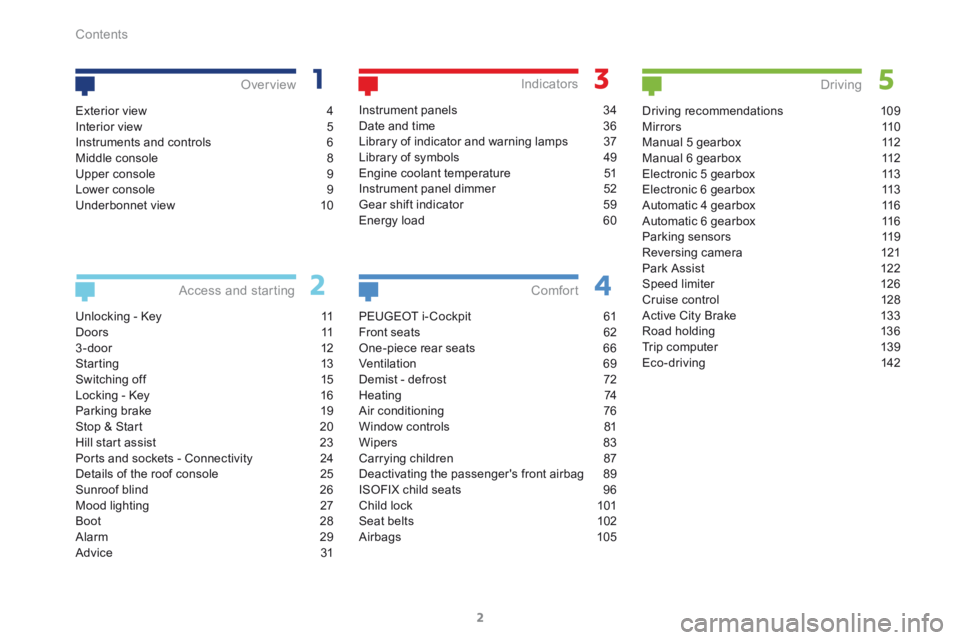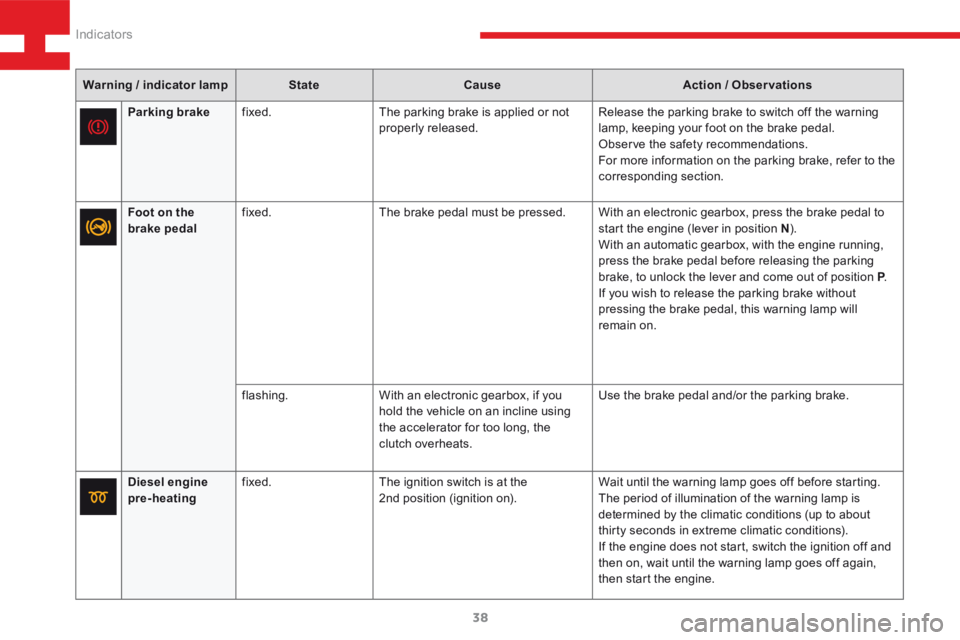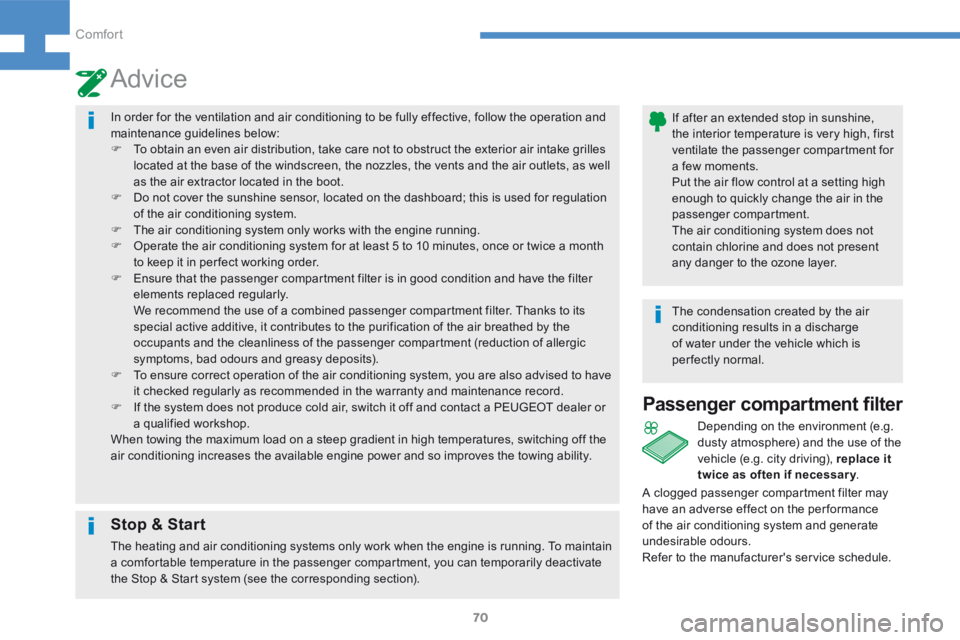Page 4 of 341

2
208_en_Chap00a_sommaire_ed01-2015
Unlocking - Key 11
D o o r s 11
3 - door 12
Starting 13
Switching off 15
Locking - Key 16
Parking brake 19
Stop & Start 20
Hill start assist 23
Ports and sockets - Connectivity 24
Details of the roof console 25
Sunroof blind 26
Mood lighting 27
Boot 28
Alarm 29
Advice 31
Access and starting Over view
Instrument panels
34
Date and time 36
Library of indicator and warning lamps 37
Library of symbols 49
Engine coolant temperature 51
Instrument panel dimmer 52
Gear shift indicator 59
Energy load 60
Indicators
PEUGEOT i- Cockpit 61
Front seats 62
One-piece rear seats 66
Ventilation 69
Demist - defrost 72
Heating 74
Air conditioning 76
Window controls 81
Wipers 83
Carrying children 87
Deactivating the passenger's front airbag 89
ISOFIX child seats 96
Child lock 101
Seat belts 102
Airbags 105
Comfort
Driving recommendations 109
M i r r o r s 11 0
Manual 5 gearbox 112
Manual 6 gearbox 112
Electronic 5 gearbox 113
Electronic 6 gearbox 113
Automatic 4 gearbox 116
Automatic 6 gearbox 116
Parking sensors 119
Reversing camera 121
Park Assist 122
Speed limiter 126
Cruise control 128
Active City Brake 133
Road holding 136
Trip computer 139
Eco-driving 142
Driving
Exterior view 4
Interior view 5
Instruments and controls 6
Middle console 8
Upper console 9
Lower console 9
Underbonnet view 10
Contents
Page 10 of 341
8
208_en_Chap01_vue-ensemble_ed01-2015
Touch screen.Heating / Ventilation.
Hazard warning lamps. Bluetooth audio system.
Audio system.
Middle console
Central locking.
Automatic dual-zone
air conditioning.
Centre console
223-285 2 87- 3 0 5
3 07- 318 74 -75
76 -77
78- 80
14 4 18
Manual air
conditioning.
Over view
Page 40 of 341

38
208_en_Chap03_Indicateurs_ed01-2015
Warning / indicator lampStateCause Action / Observations
Diesel engine
pre-heating fixed.
The ignition switch is at the
2nd position (ignition on). Wait until the warning lamp goes off before starting.
The period of illumination of the warning lamp is
determined by the climatic conditions (up to about
thirty seconds in extreme climatic conditions).
If the engine does not start, switch the ignition off and
then on, wait until the warning lamp goes off again,
then start the engine.
Parking brake
fixed. The parking brake is applied or not
properly released. Release the parking brake to switch off the warning
lamp, keeping your foot on the brake pedal.
Observe the safety recommendations.
For more information on the parking brake, refer to the
corresponding section.
Foot on the
brake pedal fixed.
The brake pedal must be pressed. With an electronic gearbox, press the brake pedal to
start the engine (lever in position N).
With an automatic gearbox, with the engine running,
press the brake pedal before releasing the parking
brake, to unlock the lever and come out of position P .
If you wish to release the parking brake without
pressing the brake pedal, this warning lamp will
remain on.
flashing. With an electronic gearbox, if you
hold the vehicle on an incline using
the accelerator for too long, the
clutch overheats. Use the brake pedal and/or the parking brake.
Indicators
Page 67 of 341
65
208_en_Chap04_confort_ed01-2015
Heated seats
With the engine running, the front seats can be
heated separately.
Armrest
Comfort and storage system for the driver and
front passenger.
Cover with opening lever
F Lift the lever to raise the lid. Storage space in the console
F
Pull the armrest fully up.
Additional adjustments
F Use the adjustment wheel, select the level
of heating required:
0 : Of f.
1 : Low.
2 : Medium.
3 : High.
4
Comfort
Page 71 of 341
69
208_en_Chap04_confort_ed01-2015
Ventilation
Air intake
The air circulating in the passenger
compartment is filtered and originates either
from the outside via the grille located at the
base of the windscreen or from the inside in air
recirculation mode.
Air intake flow
The incoming air follows various paths
depending on the controls selected by the
driver:
- direct arrival in the passenger
compartment (air intake),
- passage through a heating circuit (heating),
- passage through a cooling circuit (air
conditioning).
Control panel
The controls of this system are grouped
together on the control panel on the centre
console.
General points
Air distribution
The incoming air is distributed via various
outlets:
- windscreen demisting-defrosting vents,
- front side window demisting-defrosting
vents,
- side adjustable air vents,
- central adjustable air vents,
- air outlets to the front footwells,
- air outlets to the rear footwells.
4
Comfort
Page 72 of 341

70
208_en_Chap04_confort_ed01-2015
In order for the ventilation and air conditioning to be fully effective, follow the operation and
maintenance guidelines below:
F To obtain an even air distribution, take care not to obstruct the exterior air intake grilles
located at the base of the windscreen, the nozzles, the vents and the air outlets, as well
as the air extractor located in the boot.
F Do not cover the sunshine sensor, located on the dashboard; this is used for regulation
of the air conditioning system.
F The air conditioning system only works with the engine running.
F Operate the air conditioning system for at least 5 to 10 minutes, once or twice a month
to keep it in per fect working order.
F Ensure that the passenger compartment filter is in good condition and have the filter
elements replaced regularly.
We recommend the use of a combined passenger compartment filter. Thanks to its
special active additive, it contributes to the purification of the air breathed by the
occupants and the cleanliness of the passenger compartment (reduction of allergic
symptoms, bad odours and greasy deposits).
F To ensure correct operation of the air conditioning system, you are also advised to have
it checked regularly as recommended in the warranty and maintenance record.
F If the system does not produce cold air, switch it off and contact a PEUGEOT dealer or
a qualified workshop.
When towing the maximum load on a steep gradient in high temperatures, switching off the
air conditioning increases the available engine power and so improves the towing ability.
Advice
If after an extended stop in sunshine,
the interior temperature is very high, first
ventilate the passenger compartment for
a few moments.
Put the air flow control at a setting high
enough to quickly change the air in the
passenger compartment.
The air conditioning system does not
contain chlorine and does not present
any danger to the ozone layer.
The condensation created by the air
conditioning results in a discharge
of water under the vehicle which is
perfectly normal.
Stop & Start
The heating and air conditioning systems only work when the engine is running. To maintain
a comfortable temperature in the passenger compartment, you can temporarily deactivate
the Stop & Start system (see the corresponding section).
Passenger compartment filter
Depending on the environment (e.g.
dusty atmosphere) and the use of the
vehicle (e.g. city driving), replace it
twice as often if necessar y .
A clogged passenger compartment filter may
have an adverse effect on the per formance
of the air conditioning system and generate
undesirable odours.
Refer to the manufacturer's service schedule.
Comfort
Page 73 of 341
71
208_en_Chap04_confort_ed01-2015
Advice
Digital air conditioning: use the automatic mode in preference by pressing the "AUTO" button.
I require...
Heating or Manual air conditioning
Air distribution Air flowRecirculation of interior air /
Intake of exterior air Temperature
Manual AC
HOT
COLD
DEMISTING
DEFROSTING
Interior settings
4
Comfort
Page 76 of 341
74
208_en_Chap04_confort_ed01-2015
Temperature
F Turn the knob from blue
(cold) to red (hot) to adjust the
temperature to your wishes.
Air flow
F Turn the knob from position 1 to
position 6 , to obtain the desired
air f low. If you place the air flow control at
position 0 (off), the temperature in the
vehicle will no longer be maintained.
However, a slight flow of air can still be
felt due to the movement of the vehicle.
Heating / Ventilation
Manual mode
Comfort